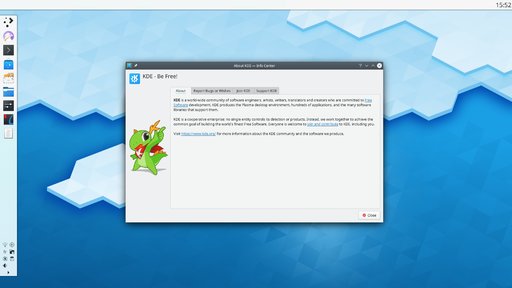Plasma/Panels/pl: Difference between revisions
No edit summary |
(Created page with "Panel może być konfigurowany poprzez kliknięcie na skrzynce narzędziowej, która znajduje się na dole po prawej stronie na panelu poziomym lub pionowym. Na ten czas panel...") |
||
| Line 9: | Line 9: | ||
== Konfiguracja == | == Konfiguracja == | ||
Panel może być konfigurowany poprzez kliknięcie na skrzynce narzędziowej, która znajduje się na dole po prawej stronie na panelu poziomym lub pionowym. Na ten czas panel będzie w trybie konfiguracji. Konfiguracja panela może się również odbywać poprzez menu kontekstowe, po kliknięciu prawym przyciskiem myszy na panelu. | |||
[[Image:Panel_Settings_resize.png|thumb|512px|center|The arrows on the edge of the panel allow the panel's size to be adjusted. Dragging the arrow makes the panel smaller or larger. Dragging the arrow when it is pointing down, moves the panel's position.]] | [[Image:Panel_Settings_resize.png|thumb|512px|center|The arrows on the edge of the panel allow the panel's size to be adjusted. Dragging the arrow makes the panel smaller or larger. Dragging the arrow when it is pointing down, moves the panel's position.]] | ||
Revision as of 22:26, 15 June 2014
Panele w Plasma Desktop

Panel jest zasobnikiem dla widgetów, który może być umieszczony po każdej stronie pulpitu. Można także umieszczać kilka paneli po tej samej stronie. W domyślnym układzie jest jeden panel, który rozciąga się po całej dolnej krawędzi pulpitu, z następującymi widgetami: menu aktywatorów aplikacji, pager pulpitowy, menedżer zadań (lista otwartych okien), tacka systemowa, menedżer urządzeń oraz zegar. Jeśli używasz laptopa, netbooka, albo innego komputera, który używa baterii pojawi się także widget monitora baterii na panelu. Na końcu panela znajduje się przycisk skrzynki narzędziowej, który może być uruchomiony, aby uzyskać dostęp do opcji konfiguracyjnych.
Konfiguracja
Panel może być konfigurowany poprzez kliknięcie na skrzynce narzędziowej, która znajduje się na dole po prawej stronie na panelu poziomym lub pionowym. Na ten czas panel będzie w trybie konfiguracji. Konfiguracja panela może się również odbywać poprzez menu kontekstowe, po kliknięciu prawym przyciskiem myszy na panelu.

Widgets in the panel can be sorted by dragging them when in configuration mode. Widgets align left in the horizontal and top in the vertical panel
The Panel Toolbox
- : Allows you to drag the panel to any of the four edges of the screen.
- (for horizontal panel): Allows the panel height to be adjusted.
- (for vertical panel): Allows the panel width to be adjusted.
- : Allows widgets to be added to the panel.
- : Allows you to add a spacer into the panel giving space between the items in it.
- The standard behavior of a spacer is that it uses as much space as possible (flexible size), but you can also set it to a . Enter the context (right click) menu and deactivate .
The "More Settings" Menu
- : Allows the alignment of the panel to be set in three pre-set positions.
-
- : Keeps the panel visible at all times, even when windows are maximised.
- : Hides the panel off screen until the mouse is placed near the screen edge.
- : This allows windows to cover the panel and if maximised, will cover the panel.
- : This allows windows to go below the panel, even when maximised.
- : Makes the panel fit to the screen edges, if it has been resized.
- : Locks the panel and widgets in position. Also hides the toolbox.
- : Removes the current panel and all widgets in it.
Under the Hood
Should anything "untoward" happen to your panel have a look at ~/.kde(4)/share/config/plasma-desktop-appletsrc - the panel itself is classed as a containment (there are at least two, the desktop and the panel) which is home to all the different widgets you put there.

Multiple Panels
It is also possible to have more than one panel on your desktop. This proves useful if you want to have a more flexible layout:

Adding a Panel
To add a new panel either click on the desktop toolbox button and select or open the context (right click) menu on the desktop and select from the menu.
If more than one kind of Panel is installed, you will be able to select between them to choose what sort of Panel you would prefer. By default, two Panel types are available: , which creates a Panel containing all of the default widgets (launcher, pager, tasks, system tray, clock, etc.), and , which adds an empty Panel without any pre-configured widgets in it.
Locking
The panels and desktop may be locked to prevent changes being made to them. When locked, the toolbox buttons will not be shown on either the desktop or on the panels. To configure a panel, it must be unlocked, otherwise the toolbox and context menu entries to configure or add widgets are unavailable.
Locking can be done by either selecting the entry in the Panel toolbox's menu or in the Panel context (right click) menu. Once locked, the Panels can be unlocked again by right clicking on either a panel or desktop and selecting from the menu that is displayed.
